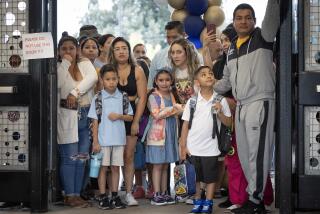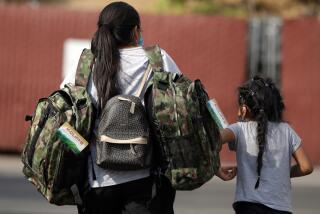Supplying Students the Right Stuff Can Mean the Right Start
It’s the first day of school and my English students are about to write a “get acquainted” essay. Right away I see that a third of them won’t be able to do the assignment.
Is it because they’re illiterate? No. It’s because they’ve come empty-handed: no notebook, no pen or paper, no place to put the books they’ll get at the end of class today. They are starting a new school year without the most basic tools of learning.
The right back-to-school supplies can greatly improve your children’s feelings about school and how well they perform there.
You need not be discouraged by the cost nor intimidated by the array of school supplies. You can give your children the right start with a simple and inexpensive survival kit that can be assembled in one trip to a discount department store, for as little as $35. With minor variations, this kit is suitable for almost anyone from lower elementary levels through high school.
First, get a backpack to hold everything. Students who don’t have one are always losing books and jamming important papers into their pockets. Nylon packs, which best repel rain and dirt, cost $12 to $30.
A notebook is indispensable, but too many are chosen for their color or the rock star on the cover. Find a three-ring, hardcover binder that has a separate section for each class and a pocket in which to keep assignments or handouts. These run from $8.95 to $12, depending on how organized your children want to be.
Avoid spiral notebooks. The fringe on the torn-out pages is a pet peeve of many teachers and visually cheapens the students’ carefully prepared assignments.
Using separate, thin folders for each class is popular but hazardous because the folders are easy to lose and students often hurriedly grab the wrong one from their lockers, so they’re stuck with algebra notes in American literature class.
White college-ruled paper is the safest bet for stocking the notebook. Some teachers are picky about the size, color and format of the paper that is used for assignments, but I don’t know of any teacher who won’t accept this standard paper for handwritten work. A 200-sheet package usually costs less than $2.
It’s amazing how many students don’t own pens, considering that formal assignments must generally be written in ink. Avoid artsy colors such as pink, lavender and teal (yes, I’ve actually received teal homework). You can’t go wrong with black or dark blue. Above all, leave the sacred privilege of red ink for the teacher. A bag of 10 ballpoints runs about $1.59.
Highlighting pens are very helpful in marking ideas in books or notes and usually come in a variety of pastels. Having a couple of colors for different purposes is handy; a single highlighting pen ranges from $1 to $4.
Calculators are an unquestioned necessity. Every student completes a series of math courses for the high school diploma, and more teachers are allowing calculators to be used in exams, so the machines can save precious time and mental energy.
Since calculators differ in capability and price ($5 to $100 and more), ask the math teacher to suggest a model. That way you’re not paying extra for functions your children will never use, but you’re also not getting a machine that can’t do enough.
We’ve all read or heard about high school students who can’t locate Washington or the Equator on a map. And since history or geography are part of the curriculum throughout junior and senior high school, a $5 wall map for the student’s bedroom is a wise investment. Colored tacks can be used to label cities or historic sites that the children have learned about.
Ultimately, the best way to ensure that your children have the right supplies is to ask their teachers to recommend materials. Most students, however, will find that this list will serve them pretty well in the school year ahead.
Mary Laine Yarber teaches English and journalism at Santa Monica High School. Her education column appears weekly.






